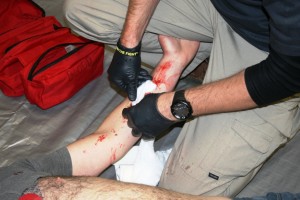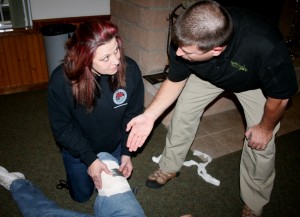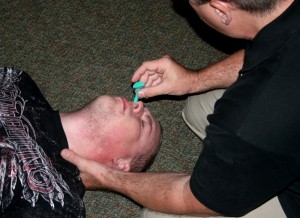Navigate This Post
[memb_include_partial id=15899]
Take note of the date and time. Check your clocks and your calendar. Write it down if you have to, I’m about to admit an error on my part. That’s right, my judgment was clouded. I mistakenly thought that when addressing the matter of traumatic first aid that “the choir” would understand.
I’m not speaking about the sheep. Sheep are by nature just that, sheep. They are subservient and rely on something other than themselves for protection and salvation. Sheep are happy in their helplessness.
Did you know that we now have digital training courses?
Click Here to gain instant access to Force Options: How to Defend Yourself Without a Weapon >>
Target Audience
I am speaking of gun owners, those who look at firearms as a tool potentially used to save their lives. I’m talking about men and women who take guns to the field and harvest wild game. These are all people who consider themselves citizens, not subjects. I’m also referring to folks who spice up their conversations with words and phrases. This is done with “terminal ballistics”, “stopping power”, “hydrostatic shock” and “permanent wound cavity”.
I’m referring to the guys who revere the names Cooper, Jordan, Keith, Browning, Winchester, and Colt. When addressing an audience populated with the aforementioned individuals I mistakenly assumed that they would appreciate and understand that any man, and I mean human, armed and prepared to take a life must at the same time be prepared and equipped to save one.
This is not the first piece I have written where I dared to mention the “T” word: tourniquet. Over the last several years I’ve penned a number of reviews mentioning life-saving, medical trauma training and gear available to U.S. Military troops, law enforcement officers, and citizens alike. These reviews were not published in the “Ladies Home Journal” or “Cat Fancy”, they were printed in paper and electronic media geared toward the meat-eater. Despite this attempt to target the correct audience, I’ve experienced such a cacophony of whining, moaning, and lame excuse offering that I can no longer hold it in.
Willing to Kill but not Heal
For every review written that addresses Tactical Combat Casualty Care or what I call “Beyond the Band-Aid” training, there are hundreds more written by myriad authors and bloggers extolling the virtues of this firearm or that as the greatest “man-stopper”. We promote personal defense ammunition based on expansion qualities, wound cavity, “energy transfer”, and, of course, our favorite “stopping power”.
Were the society’s sheep to happen on any of these gun and ammo articles they would likely faint away from shock. But the choir embraces them. They memorize the paragraphs and regurgitate the words in a future gun shop or shooting range conversations. Never does it occur to these folks to pen a letter to the editor. Or “blog” their disgust about the author’s discussion of lethal force or for implying that one man might be forced to kill another man. Let alone recommend the best tool for doing so. These issues don’t give them a moment of pause.
When these same people stumble upon an article that mentions the words tourniquet, pressure dressing, nasal airway, or chest decompression needle they become apoplectic. When the suggestion is made that a citizen, given an amount of professional first aid training can be equipped to stop a life-threatening injury and stabilize a trauma victim until the professionals arrive, they are beside themselves.
The excuses are innumerable and not based on logic or experience but emotion, preconceived notions, and misconception. Many will fall back on the decades-old “ABC” patient assessment taught by the American Red Cross. I like the Red Cross, and I was one of their instructors years ago. I’ve been certified and re-certified in “Family First Aid”, CPR and the Heimlich maneuver more than I can remember.
Change
Guess what? The CPR I was taught in Jr. High in 1981, don’t laugh, is not the same as the CPR taught today. It has been updated and modified, numerous times. Telling me that you were in the Army in 1987 and they told you never to use a tourniquet or “only as a last resort after all other means had failed” does not impress me.
By the same token, relating that you are an Intergalactically Certified EMT (cue Beastie Boys music) and that your S.O.P. expressly forbids the use of a tourniquet except as a last resort again does not blow up my skirt. You show up on scene with an Emergency Room on wheels. You have a huge backpack full of medical goodies and a buddy or two to help you use it all.
All the naysayers, the Monday Morning quarterbacks, and disapproving civilian medics are completely missing the point of the exercise. That point being a first aid trained individual using readily available and easy to carry material (no whole blood, IV fluid, pumps, masks, O2 etc.) to stop-gap a genuine life-threatening injury until professional medical personnel can arrive. “I don’t need to learn that, emergency medicine is best left to the trained professionals”. That is exactly what the sheep say about defending yourself with a gun. Leave it to “professionals”.
Reality, not Fantasy
Right now on planet Earth there are innumerable men and women walking around above ground. All because of the Tactical Combat Casualty Care (TCCC) program. Men and women are alive that somehow, by the grace of God, survived the physical and emotional distress of having a tourniquet stop an arterial bleeding injury while they awaited transport to a trauma center. And, many have all FOUR limbs to boot. American servicemen are with their families today because another trooper, not a doctor or medic, kept an airway open by putting a tube into their nose or stopped a tension pneumothorax from killing them by relieving the pressure with a big, scary needle.
What does all this have to do with stateside medical care or “Beyond the Band-Aid” first aid training? It’s no more difficult than understanding that a severed artery in Iraq and a severed artery in Tampa, Florida have the same result; the death of the victim in minutes, two or three, not five or ten. High speed vehicle crashes often produce partial or complete amputations. If an artery in the victim’s arm or leg is compromised only those at the scene will have any chance of saving their lives. The ambulance crew five to ten minutes away cannot arrive in time to stop a true life-threatening bleeding injury. But you could.
We Are All Vulnerable
For those of you who carry a gun for self-preservation, congratulations, you are doing the right thing. You must understand that even if you win the gunfight you can end up bleeding. I have a close friend who won his gunfight but still ended up with a bullet in the upper chest. The good guys can bleed too. How would you feel if you stopped an assault by a crazed drug-addict only to discover that your wife, husband, or child now lay critically wounded? As a result, there they lay at your feet and there is nothing you can do but hold their hand and pray for an ambulance?
A Search for Balance
In his book, The Five Rings, Miyamoto Musashi admonishes that “A warrior should have an understanding of the peaceful arts as well as the killing arts.” Musashi advised that if a warrior is to learn the true Way, he needs to study more than just the sword. He should study art and poetry and sculpture. Would not the study of traumatic first aid, the ability to stop-gap a mortal injury, fall into this category?
You may study TCCC or Beyond the Band-Aid first aid and never be called upon to use it. The same could be said for your firearm and yet there it is. We, the choir, the ones who should be enlightened spend much of our time learning and practice putting holes in things. Should not some of that effort be put into plugging the holes?
If you’ll brag to your fellows about the new super-death machine you bought at the last gun show but the word tourniquet sends you running, you need to take a long hard look in the mirror before casting stones. Do you willingly and readily talk about using deadly force? Yet at the same time are too squeamish to consider emergency first aid to save a life? If the answer is yes, I would offer that you have your priorities out of order.
Have you ever been in a situation where you could have/did have to stop-gap a life-threatening injury until the professionals could get to the scene? Tell us about your experience in the comments below!
CLICK HERE to apply to be part of The Student Lounge.
Professor Paul Markel
Latest posts by Professor Paul Markel (see all)
- Tactical Masturbation: Top 3 Stupid Human Tricks - July 8th, 2024
- Blood Trail: Fearless Fiction - June 21st, 2024
- SOTG and SB Tactical Celebrate Brace Ruling - June 20th, 2024
- Shotgun Accessories: Practical and Useful - June 14th, 2024
- Tactical Rifle Tips: Transition Drills - January 5th, 2024










Yup, the odds that you’ll use your first aid training, (and the first aid kit I know you have in your EDC), would seem to far outweigh the odds of presenting a firearm. Take out all the gunfighting stuff, you’re still more likely to come across a heart attack or injury from an accident. I think the point also needs to be made (reiterated) that there is no need to learn to splint a broken arm 6 ways from Sunday or start an IV. Only a few life saving techniques need to be learned. If you’re a sheepdog with a gun you ought to be a sheepdog with a trauma kit as well.
Thanks for the article. Not all of us vegans fall under your stereotype btw.
Agree with Marty and I have been first on the scene with my First Aid Kit at Home, having to Assess, Adapt & Overcome with someone bleeding is NO FUN! I now try to keep my Pocket Trauma Kit ( from SOTG Store) like a Katana- always within Arms Reach.
Wow, Quoting The Five Rings & Sun Tzu in one week- Impressive!!!
Thanks-Important Topic!
I went through combat lifesaving right before exiting the service, i earned the right to carry the “bag”. Picked one up as soon as i could and had it filled and i cary it with me to this day. It doesn’t have all the new pieces that they do now, and i was trained with a j-tube instead of the one for the nose, i try and remember all the training I had then and teach it to my kids that are both in boyscouts. I would love to kit up further but money is always an issue, so i deal with what i have and pass on my knowledge, if it spurts put a tourniquet or pressure bandage on it.
The most important piece of equipment inany medical emergency is the one paced between your ears. RTB, USA (ret) PA>
I went through combat lifesaving right before exiting the service, i earned the right to carry the “bag”. Picked one up as soon as i could and had it filled and i cary it with me to this day. It doesn’t have all the new pieces that they do now, and i was trained with a j-tube instead of the one for the nose, i try and remember all the training I had then and teach it to my kids that are both in boyscouts. I would love to kit up further but money is always an issue, so i deal with what i have and pass on my knowledge, if it spurts put a tourniquet or pressure bandage on it.
The most important piece of equipment inany medical emergency is the one paced between your ears. RTB, USA (ret) PA>
Yup, the odds that you’ll use your first aid training, (and the first aid kit I know you have in your EDC), would seem to far outweigh the odds of presenting a firearm. Take out all the gunfighting stuff, you’re still more likely to come across a heart attack or injury from an accident. I think the point also needs to be made (reiterated) that there is no need to learn to splint a broken arm 6 ways from Sunday or start an IV. Only a few life saving techniques need to be learned. If you’re a sheepdog with a gun you ought to be a sheepdog with a trauma kit as well.
Thanks for the article. Not all of us vegans fall under your stereotype btw.
Agree with Marty and I have been first on the scene with my First Aid Kit at Home, having to Assess, Adapt & Overcome with someone bleeding is NO FUN! I now try to keep my Pocket Trauma Kit ( from SOTG Store) like a Katana- always within Arms Reach.
Wow, Quoting The Five Rings & Sun Tzu in one week- Impressive!!!
Thanks-Important Topic!